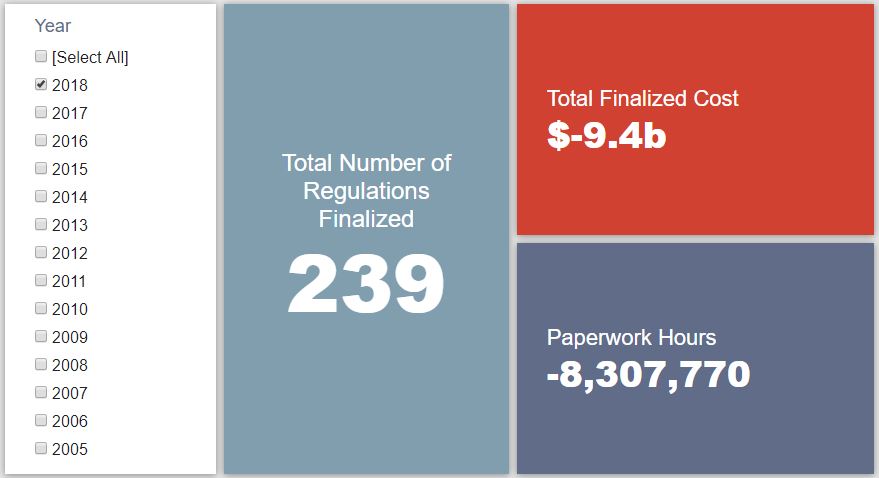Week in Regulation
October 9, 2018
Deregulatory Proposals Lead Off the New Fiscal Year
A series of proposed rules with modest cost reductions was the primary driver of regulatory trends last week. These proposals covered such topics as refrigerant chemical standards, Medicare appeals, and verification requirements for free and reduced-price meal programs. Between both proposed and final rules last week, agencies published roughly $49.7 million in net cost savings, and reduced paperwork by 386,173 hours. The per capita regulatory burden for 2018 is negative $28.42.
REGULATORY TOPLINES
- New Proposed Rules: 41
- New Final Rules: 76
- 2018 Total Pages of Regulation: 50,204
- 2018 Final Rules: -$9.4 Billion
- 2018 Proposed Rules: -$545.9 Billion
TRACKING REGULATORY MODERNIZATION
With Fiscal Year (FY) 2018 officially over, one can now look back at the totality of its regulatory budget picture under Executive Order (EO) 13,771. According to American Action Forum (AAF) tracking of all relevant final rules that provided some cost or savings estimate, the administration published 65 deregulatory actions against 12 regulatory actions and exceeded its cumulative goal by nearly $1 billion in annualized savings. The Departments of Health and Human Services (HHS), Interior, and Labor were the three most prodigious cost-cutters among Cabinet agencies. Additionally, there was a notable shift in agencies finally implementing more substantive deregulatory actions rather than simply delaying certain rules. Between both FY 2018 and a truncated FY 2017, EO 13,771 actions have produced roughly $2.2 billion in net annual savings.
The new regulatory budget “caps” for FY 2019 are still forthcoming, but there was one – albeit minor – deregulatory rule to kick things off. The rule out of the Department of Veterans Affairs streamlines certain reporting requirements for relevant contractors. The savings, however, are relatively minimal: 1,255 fewer hours of paperwork with roughly $58,000 in commensurate cost savings.
While proposed rules do not accrue to the EO 13,771 budgets until they are finalized, there were some interesting proposals this week. Given how early in the fiscal year they’ve come, it is very possible that they may eventually be a part of the FY 2019 budget. The first is an Environmental Protection Agency action regarding “Revisions to the Refrigerant Management Program’s Extension to Substitutes” that could save roughly $24 million annually. The next measure out of HHS would save $9.5 million annually by streamlining “the appeals process that Medicare beneficiaries, providers, and suppliers must follow.” And finally, the Department of Agriculture seeks to reduce the reporting burden on for-profit entities participating in the Child and Adult Care Food Program. The agency estimates that this could lead to 43,559 fewer hours of paperwork annually, saving roughly $2.2 million each year.
STATE OF MAJOR OBAMA-ERA INITIATIVES
Based on total lifetime costs of the regulations, the ACA has imposed costs of $52.9 billion in final state and private-sector burdens and 176.9 million annual paperwork hours.
Since passage, the Dodd-Frank financial reform legislation has produced more than 82.9 million final paperwork burden hours and imposed $38.9 billion in direct compliance costs.
TOTAL BURDENS
Since January 1, the federal government has published $555.3 billion in net cost savings (with $9.4 billion in net savings from final rules) and paperwork burdens amounting to roughly 4.6 million hours (including 8.3 million hours of paperwork reduced under final rules). Click here for the latest Reg Rodeo findings.











